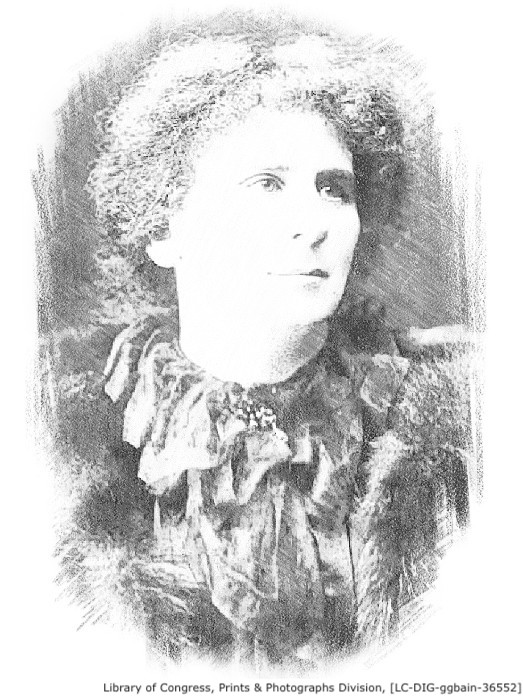Hertha Marks Ayrton
Hertha Marks Ayrton was a distinguished British mathematician, electrical engineer, and inventor, known for her work on mathematical dividers, electric arcs, and the propulsion of air. Ayrton was the first woman to be recommended for fellowship of the British Royal Society, but her candidacy was denied on the grounds that as a married woman she had no legal existence in British law. She went on to become very involved in the suffragette movement, advocating for the rights of women in all areas of life.
Born on April 28, 1854 in Portsea, England by the name of Phoebe Sarah Marks, Hertha Marks Ayrton was one of eight children. Her father was a clockmaker and jeweler, who had escaped anti-Semitic persecution in his native Poland. He died in 1861 and left the family in debt. Her mother supported the family with needlework and philanthropic ventures. Marks went to live with her aunt in London, who taught her from the age of nine. There, she learned French and music, as well as math and Latin from her cousins. Marks worked as a live-in-governess at age 16 in London, sending money back to her family.
She took on the name Hertha, who was the heroine of a novel by the feminist Swedish writer, Frederika Bremer. Barbara Bodichon, the leader of the Langham Place feminist activists, co-founded the first college for women in England, Girton College in Cambridge. After interviewing Hertha, Bodichon organized and paid for her advanced mathematics lessons and arranged a loan so that she could attend Girton. Marks entered Girton in 1876 after having passed the Cambridge University Examination for Women in 1874 with honors in English and mathematics. She was informally placed in the third class, as women were not eligible for a university degree at the time.
Marks’ first invention was a line divider, which received a lot of attention and press at the Exhibition of Women’s Industries. It was used to divide a line into equal parts, primarily used by artists to enlarge and diminish, but also useful to engineers and architects. With the financial help of her mentor Barbara Bodichon, she was able to purchase a patent. Ayrton’s 1884 patent was the first of 26 in her lifetime.
Marks began taking night classes at Finsbury Technical College, where she met and married her professor, William Ayrton. She became a step-mother to his daughter and gave birth to her own daughter a year later, named Barbara in honor of her mentor. While helping her husband replicate his experiments on the electric arc, after a fire destroyed his papers, she made a significant scientific discovery. Electric arcs were used to produce bright light. The carbon electrodes and the gas between them were heated white-hot by the high-voltage discharge. Ayrton connected the length of the arc with pressure and voltage, and traced the hissing noise to oxidation rather than evaporation of the electrode material.
Ayrton published her work in The Electrician in 1895 and she was invited to read four years later at the Institution of Electrical Engineers. She was the first woman elected to its membership and received one of their prizes. She spoke at the International Electrical Congress in Paris the following year in 1900, and her success led to the British Association for the Advancement of Science to allow women to serve on general and sectional committees. She published her book, the Electric Arc in 1902.
Ayrton became the first woman to read to the Royal Society, who awarded the Hughes Medal to her in 1906 for her work on the electric arc and sand ripples. Two years later, her husband died. A widower with a young daughter, Ayrton had to support her family and was a huge advocate of women’s education and legal rights. As a close friend of Marie Curie’s, Ayrton conducted a vigorous campaign in the press when Curie’s discovery of radium had been attributed to her husband. She became the organizer for the Women’s Social and Political Union and was imprisoned for smashing windows in 1912 in London. Two years later, she gave 100 Euros to help form the United Suffragists, which included both men and women. She was vice-president and her daughter, Barbara, its honorary secretary.
During World War I, mustard gas and other deadly gases were used as weapons. In 1915, Ayrton invented a hand-operated fan to get rid of poisonous gases from the trenches at the front. The device had a waterproof canvas supported by braces of a cane with two hinges and a hickory handle. The invention was dismissed by the War Office initially, until press exchanges followed, and they finally issued 104,000 “Ayrton Fans” to soldiers on the western front.
Ayrton spent the rest of her career involved in research to clear noxious vapors from mines and sewers and became involved in the newly founded International Federation of University Women.
Ayrton died on August 26, 1923 of septicemia, a bacterial infection.


